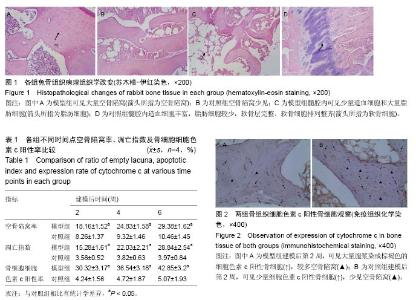| [1] Wang C, Peng J, Lu S. Summary of the various treaments for osteonecrosis of the femoral head by mechanism: a review. Exp Ther Med. 2014;8(3): 700-706.
[2] Yawon H, Jinuk P, Seok HC. Traumatic and non-traumatic osteonecrosis in the femoral head of a rabbit model. Lab Anim Res. 2011;27(2):127-131.
[3] Tripathy SK, Goyal T, Sen RK, et al. Management of femoral head osteonecrosis: current concepts. Indian J Orthop. 2015;49(1):28-45.
[4] Levasseur R. Mechanisms of osteonecrosis. Joint Bone Spine. 2008;75(6):639-642.
[5] 王小龙,赵建民,刘瑞,等.细胞凋亡在激素诱导性股骨头坏死中的研究进展[J].实用骨科杂志,2015,21(1): 56-59.
[6] 少华,崔超,常巍,等.激素性股骨头缺血性坏死细胞凋亡的实验研究[J].中华实用诊断与治疗杂志,2010,24(4): 368-370.
[7] Youm YS, Lee SY, Lee SH. Apoptosis in the osteonecrosis of the femoral head. Clin Orthop Surg. 2010;2(4):250-255.
[8] Tian L, Dang XQ, Wang KZ, et al. Effects of sodium ferulate on preventing steroid-induced femoral head osteonecrosis in rabbit. J Zhejiang Univ Sci B. 2013; 14(5):426-437.
[9] 刘江涛,郭雄,吴翠艳,等.线粒体细胞色素c 介导的caspase-9激活通路参与大骨节病关节软骨细胞凋亡的发生机制[J].西安交通大学学报(医学版),2011,32(5): 580-584.
[10] 邹循锋,鄢业鸿.线粒体细胞色素C介导的凋亡通路的研究进展[J].医学综述,2007,13(1):16-19.
[11] 张立岩,孙新,田丹,等.兔早期激素性股骨头缺血性坏死模型建立及其MRI与病理特征研究[J].中国修复重建外科杂志,2015,29(10):1240-1243.
[12] Wang XL, Liu Y, Wang XM, et al. The Role of 99mTc-Annexin V Apoptosis Scintigraphy inVisualizing Early Stage Glucocorticoid-Induced Femoral Head Osteonecrosis in the Rabbit. Biomed Res Int. 2016.
[13] 李传将,王万明,庄颜峰,等.改良激素性股骨头坏死动物模型的建立与评价[J].中国修复重建外科杂志,2015,29(10): 1240-1243.
[14] 李瑞琦,张国平,李宜炯,等.激素性股骨头缺血性坏死模型:不同构建技术分析[J].中国组织工程研究, 2013,17(37): 6676-6681.
[15] 王远贺,张才龙,田少奇,等.激素性兔股骨头坏死模型的建立[J].中国组织工程研究与临床康复,2011,15(24): 4419-4422.
[16] Matsui M, Saito S, Ohzono K, et al. Experimental steroid-induced osteonecrosis in adult rabbits with hypersensitivity vasculitis. Clin Orthop Relat Res. 1992; 277:61-72.
[17] Yamamoto T, Hirano K, Tsutsui H, et al. Corticosteroid enhances the experimental induction of osteonecrosis in rabbits with Shwartzman reaction. Clin Orthop. 1995; 316:235-243.
[18] 张国桥,易诚青,滕松松,等.早期激素性股骨头缺血性坏死模型的建立[J].现代生物医学进展,2012,12(7): 1223-1224.
[19] 李超,尚希福,李旭,等.提高激素性股骨头缺血性坏死兔模型动物存活率的实验研究[J].安徽医科大学学报,2014, 49(12):1726-1729.
[20] 杨帆,朱振中,李广翼,等.股骨头缺血性坏死病理形态学研究进展[J].国际骨科学杂志, 2014,35(5):313-315.
[21] 闵红巍,刘克敏,王安庆,等.改良激素法建立早期股骨头坏死动物模型[J].中国康复理论与实践,2014,20(6): 527-532.
[22] 赵振群,刘万林,龚瑜林,等.骨髓造血细胞DNA氧化损伤与骨细胞凋亡:在早期激素性股骨头坏死中的表现[J].中国组织工程研究,2015,19(11):1652-1657.
[23] Kale J, Liu Q, Leber B, et al. Shedding light on apoptosis at sub-cellular membranes. Cell. 2012; 151(6):1179-1184.
[24] Weinstein RS, Nicholas RW. Apoptosis of osteocytes in glucecorticoid-induced ostennecrosis of the hip. J Clin Endecrinol Metab. 2000;85(8):2907-2912.
[25] Kerachian MA, Harvey EJ, Cournoyer D, et al. A rat model of early stage osteonecrosis induced by glucocorticoids. J Orthop Surg Res. 2011;6(1):62-68.
[26] Kerachian MA, Cournoyer D, Harvey EJ, et al. New insights into the pathogenesis of glucocorticoid-induced avascular necrosis: microarray analysis of gene expression in a model. Arthritis Res Ther. 2010;12(3):2-12.
[27] Eberhardt AW, Yeaqer-Jones A, Blair HC. Regional trabecular bone matrix degeneration and osteocyte death in femora of glucocorticoid-treated rabbits. Endocrinology. 2001;142(3):1333-1340.
[28] 熊明月,王坤正,党晓谦.早期激素性股骨头坏死骨细胞凋亡的实验研究[J].中国修复重建外科杂志,2007,21(3): 262-265.
[29] 胡峰,赵劲民,李晓峰,等.早期激素性股骨头缺血性坏死模型的建立及半胱天冬酶3活性测定[J].中国组织工程研究与临床康复,2012,14(20):3701-3704.
[30] 刘文刚,何伟,许学猛,等.兔激素性股骨头坏死与肝细胞色素P4503A 酶活性的相关性研究[J].中医正骨,2011, 23(10): 6-8.
[31] 韦武亭,王汉东,吴永,等.α-硫辛酸在小鼠创伤性脑损伤中抗神经细胞凋亡的作用[J].医学研究生学报,2015,28(6): 574-578.
[32] Cabahug-Zuckerman P, Frikha-Benayed D, Majeska RJ, et al. Osteocyte Apoptosis Caused by Hindlimb Unloading is Required to Trigger Osteocyte RANKL Production and Subsequent Resorption of Cortical and Trabecular Bone in Mice Femurs. J Bone Miner Res. 2016;31(7):1356-1365.
[33] Ren QG, Yang SL, Hu JL, et al. Evaluation of HO-1 expression, cellular ROS production, cellular proliferation and cellular apoptosis in human esophageal squamous cell carcinoma tumors and cell lines. Oncol Rep. 2016;35(4):2270-2276.
[34] Ji XM, Wu ZC, Liu GW, et al. Wenxia Changfu Formula () induces apoptosis of lung adenocarcinoma in a transplanted tumor model of drug-resistance nude mice. Chin J Integr Med. 2015.
[35] Sturzu A, Sheikh S, Echner H, et al. Chemosensitization of prostate carcinoma cells with a receptor-directed smac conjugate. Med Chem. 2016; 12(5):412-418.
[36] Anderson KJ, Russell AP, Foletta VC. NDRG2 promotes myoblast proliferation and caspase 3/7 activities during differentiation, and attenuates hydrogen peroxide - But not palmitate-induced toxicity. FEBS Open Bio. 2015;5:668-681.
[37] Wang GW, Lv C, Shi ZR, et al. Abieslactone induces cell cycle arrest and apoptosis in human hepatocellular carcinomas through the mitochondrial pathway and the generation of reactive oxygen species. PLoS One. 2014; 9(12):e115151.
[38] Choi WS, Oh YJ. Calbindin-D28K Prevents Staurosporin-induced Bax Cleavage and Membrane Permeabilization. Exp Neurobiol. 2014;23(2):173-177.
[39] Papanikolaou X, Johnson S, Garg T, et al. Artesunate overcomes drug resistance in multiple myeloma by inducing mitochondrial stress and non-caspase apoptosis. Oncotarget. 2014;5(12):4118-4128.
[40] Oliveira MA, Ferreira LC, Zuccari DA, et al. Comparison of the solution of histidine-tryptophan- alfacetoglutarate with histidine-tryptophan-glutamate as cardioplegic agents in isolated rat hearts: an immunohistochemical study. Rev Bras Cir Cardiovasc. 2014;29(1):83-88.
[41] Wu M, Zhang H, Hu J, et al. Isoalantolactone inhibits UM-SCC-10A cell growth via cell cycle arrest and apoptosis induction. PLoS One. 2013;8(9):e76000.
[42] Zeng KW, Li N, Dong X, et al. Sprengerinin C exerts anti-tumorigenic effects in hepatocellular carcinoma via inhibition of proliferation and angiogenesis and induction of apoptosis. Eur J Pharmacol. 2013;714 (1-3): 261-273.
[43] Zhou Z, Li Q, Liu W, et al. Photo-killing mechanism of 2-demethoxy-2,3-ethylenediamino hypocrellin B (EDAHB) to HeLa cells. J Photochem Photobiol B. 2012;117:47-54. |

